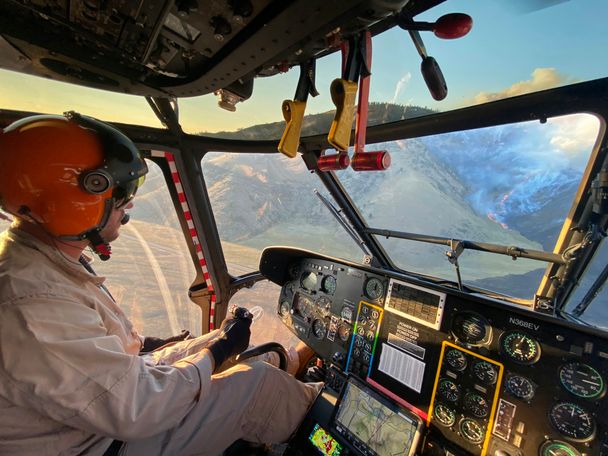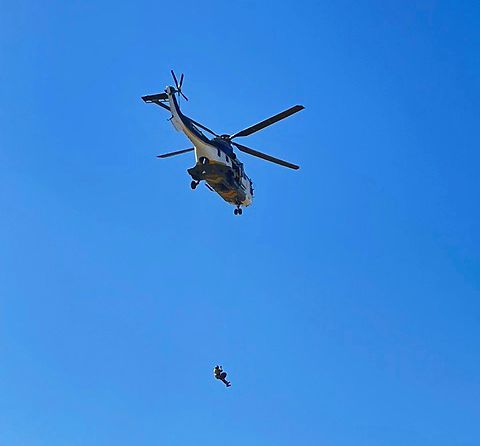Putting out fires with Precision

The Super Puma has proved itself as an optimal fire mitigation support worldwide. However, despite having fought fires in notable hotspots such as Canada, Chile, France and Greece it has been slightly less present at United States wildfires – though according to US based operator, Precision, that could be about to change. Matt Parker, Precision’s Unmanned Business President and Ty Burlingham, Precision’s Helicopter Unit Chief Pilot tell Airbus Helicopters why American firefighters are starting to take notice of the H215.
“If they want us there, we can get there,” explains Burlingham, when asked about the places Precision operates. “Wherever we’re needed, we will go. We operate all over the US for fire mitigation. What really showcased the abilities of the aircraft was when we ended up down in Chile for the fire season. In South America you see a lot more Super Pumas on rotation and ours probably flew around 205 hours in about 45 days.”

Fire proved
With a mixed fleet that includes several Airbus helicopters, ranging from the H125 to the H215, Precision has deep experience of vertical lift solutions. The company’s ethos of operating wherever they are needed is not merely limited to their fire mitigation activities. Deploying their assets and expertise across a huge variety of missions - from providing surveillance of protected wildlife and natural environments, to supporting special military operations - their business depends on matching the right tool, to the right operation. With the Super Puma’s capacity to hold up to 18 firefighters and capability of deploying 24 cycles or trips of a 4,000 litre / 1,000 gallon bucket, in two hours, it certainly offers invaluable support. Each firefighting asset has an important role in the entire mission but none has the ability to put precise water drops with as many cycles per hour as that of the helicopter.

Precision’s multi-mission business model also means they know what they’re talking about regarding the effectiveness of certain helicopters when performing certain missions, so when they’re as effusive in their praise of the H215, their opinion, like the helicopter itself, carries a lot of weight. “The [US] Forest Service really fell in love with the helicopter,” says Parker, explaining that the Super Puma is seriously bolstering its reputation in the country. “Its speed, range, fuel load and the fact that we carry a thousand gallon bucket. All the fire agencies I talked to are super excited to have that capability. On a fire, they [the H215s] get used a lot. Sometimes you get to a fire and you’re not the first one that gets called up but with the Super Puma, when it’s on the fire, it’s constantly working”.

Burlingham agrees: “For sure. We’re the kid at school with the new toy and everybody wants to see it. Firefighters constantly ask questions when we’re overhead saying ‘what is that thing?’ and want to know how big the bucket is. They ask us how long we can be on station and when other similarly sized helicopters answer back with two hours and we respond with three and half hours on station – they’re very impressed with how long we can support them.” Despite a proven track record spanning many decades of operations, the Super Puma continues to win new admirers every time it flies.
A little drone with a big Flex…

Another tool Precision deploys to support fire mitigation operations is the Flexrotor, a tactical unmanned aerial system (UAS). Having begun using the Flexrotor for conservation and anti-poaching reconnaissance in 2016, Precision quickly understood that it possessed some impressive technology for a VTOL weighing a mere 25kg / 55lbs, which elevated it above other rival UAS. “It’s a testament to [Aerovel co-founder and Chief Technology Officer] Tad McGeer’s engineering, that it clocked up 1000 flight hours on one of its first missions. Normally you have to replace the UAS, or key components, after about 250 to 300 hours. The fact that it’s a tail sitting VTOL means the sensors last a lot longer and it offers the ability to operate in confined spaces others cannot. It’s incredibly durable.”
Precision realised that, with some tweaking, it could be applied to a range of missions. “Our business is dictated by reliability and resolution,” states Parker. “If you have the highest resolution camera on the most reliable aircraft, you’re going to stay in business. That’s what the Flexrotor represented to us.” They began collaborating with Tad McGeer’s team to upgrade the camera to the best available, increased the secondary payload by a kilo and a half and ensured it could be assembled simply, with no tools required.
Operationally, the Flexrotor can fly for more than 12 hours on firefighting missions, “which is three to four more than a manned asset could fly” points out Burlingham. “And it can fly in the evening when the helicopter is on the ground”. The UAS can be dynamically tasked, or its trajectory plotted with set waypoints and preprogrammed to fly a set orbit around a map. “Or you can fly it using the camera, with given parameters of altitude and speed,” explains Parker. “It’s incredibly easy to use and it only needs two people as crew for a wildfire.” It provides firefighters with the most up-to-date information, which is naturally invaluable in such an urgent situation. Firefighters can look at the live footage that’s being streamed and check the progress of their work and be better placed to identify where the fire is or will move to – even on occasion showing that a fire previously thought to be extinguished was still active – allowing them to optimise their movements, in the most urgent of situations.
According to Parker, the next steps are to have Flexrotor and Super Puma operating on the same fire. “I’m not sure it’s happened yet,” he notes. “But there would definitely be advantages.”


